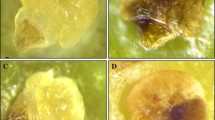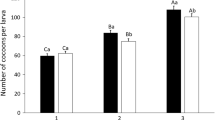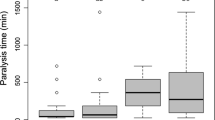Abstract
Extensive study of insect immune systems has yielded abetter understanding of the mechanisms used by insects to defendagainst invaders. This knowledge can be used to predict hownatural enemies utilize potential hosts, which will aid in theplanning of biological control programs. Our experimental systemconsists of novel host-parasitoid associations, with two NewWorld pyralid stalk borers, Diatraea saccharalis and D.grandiosella; one Old World crambid borer, Ostrinia nubilalis;and three Old World microgastrine braconid parasitoids, Cotesiachilonis, C. sesamiae, and C. flavipes. Experiments on hostsuitability indicate that parasitoids that are taxonomically,behaviorally and ecologically very similar may differ in theirability to utilize a host of the same species. Likewise,utilization of related hosts can produce different outcomes for agiven parasitoid species. D. saccharalis is a suitable host forall three parasitoid species, whereas D. grandiosella oftenencapsulates C. sesamiae and C. flavipes. O. nubilalis is anunsuitable host for all three species. Different species ofparasitoids may use different factors at different times afterparasitization to counter the host's immune response. This studysuggests that the physiological host range of these parasitoids willbe narrow, thus limiting effects on non-target species. However,the lack of consistent patterns also shows that explicit testingwill be needed to determine host ranges.
Similar content being viewed by others
References
Alleyne, M. and N.E. Beckage, 1997. Parasitism-induced effects on host growth and metabolic efficiency in tobacco hornworm larvae parasitized by Cotesia congregata. J. Insect Physiol. 43: 407-424.
Asgari, S. and O. Schmidt, 1994. Passive protection of eggs from the parasitoid, Cotesia rubecula, in the host, Pieris rapae. J. Insect Physiol. 40: 789-795.
Austin, A.D. and P.C. Dangerfield, 1989. The taxonomy of New World microgastrine braconids (Hymenoptera) parasitic on Diatraea spp. (Lepidoptera: Pyralidae). Bull. Entomol. Res. 79: 131-144.
Beckage, N.E. and M.R. Kanost, 1993. Effects of parasitism by the braconid wasp Cotesia congregata on host hemolymph proteins of the tobacco hornworm, Manduca sexta. Insect Biochem. Molec. Biol. 23: 643-653.
Brewer, F.D., B. Glick and S.B. Vinson, 1972. An immunological investigation of the factor(s) responsible for the resistance of Heliothis zea and susceptiblility of Heliothis virescens to the parasitoid Cardiochiles nigriceps. Comp. Biochem. Physiol. 43B: 781-786.
Carton, Y. and J.R. David, 1983. Reduction of fitness in Drososphila adults surviving parasitization by a cynipid wasp. Experientia 39: 231-233.
Carton, Y. and H. Kitano, 1981. Evolutionary relationships to parasitism by seven species of the Drosophila melanogaster subgroup. Biol. J. Linn. Soc. 16: 227-241.
Cate, J.R. and J.V. Maddox, 1994. Host specificity in biological control agents. Report National Audubon Society, Washington, DC.
Dahlman, D.H., 1991. Teratocytes and host/parasitoid interactions. Biol. Control 1: 118-126.
Davies, D.H. and S.B. Vinson, 1986. Passive evasion by eggs of braconid parasitoid Cardiochiles nigriceps of encapsulation in vitro by haemocytes of host Heliothis virescens. Possible role for fibrous layer in immunity. J. Insect Physiol. 32: 1003-1010.
Davis, F.M., 1989. Rearing the southwestern corn borer and fall armyworms at Mississippi State. In Toward insect resistant maize for the third world. Proceedings of the International Symposium on Methodologies for Developing Host Plant Resistance to Insects. Mexico, DF. pp. 27-36.
DeBach, P. and D. Rosen, 1991. Biological control by natural enemies, 2nd edn. Cambridge University Press, Cambridge.
Delpuech, J.-M., F. Frey and Y. Carton, 1994. Genetic and epigenetic variation in suitability of a Drosophila host to three parasitoid species. Can. J. Zool. 72: 1940-1944.
Drooz, A.T., A.E. Bustillo F.G. Fedde and V.H. Fedde, 1977. North American egg parasite successfully controls a different host genus in South America. Science 197: 390-391.
Edson, K.M., M.R. Barlin and S.B. Vinson, 1982. Venom apparatus of braconid wasps: Comparative ultrastructure of reservoirs and gland filaments. Toxicon 20: 553-562.
Fellowes, M.D.E., A.R. Kraaijeveld and H.C.J. Godfray, 1998. Trade-off associated with selection for increased ability to resist parasitoid attack in Drosophila melanogaster. Proc. R. Soc. Lond. Ser. B 265: 1553-1558.
Fellowes, M.D.E., A.R. Kraaijeveld and H.C.J. Godfray, 1999. The relative fitness of Drosophila melanogaster (Diptera: Drosophilidae) after successful defence against the parasitoid Asobara tabida (Hymenoptera: Braconidae). J. Evol. Biol.
Greany, P., W. Clark S. Ferkovich J. Law and R. Ryan, 1989. Isolation and characterization of a host hemolymph protein required for development of the eggs of the endoparasite Microplitis croceipes. In International Symposium of Molecular Insect Science, Tucson, AZ.
Greathead, D.J., 1986. Parasitoids in classical biological control. In: J. Waage and D. Greathead (eds), Insect parasitoids. Academic Press, London.
Harvey, J.A., I.F. Harvey and D.J. Thompson, 1995. The effect of host nutrition on growth and development of the parasitoid wasp Venturia canescens. Ent. Exp. Appl. 75: 213-220.
Harvey, J.A., D.J. Thompson and T.J. Heyes, 1996. Reciprocal influences and costs of parasitism on the development of Corcyra cephalonica and its endoparasitoid Venturia canescens. Ent. Exp. Appl. 81: 39-45.
Harvey, J.A. and L.E.M. Vet, 1997. Venturia canescens parasitizing Galleria mellonella and Anagasta kuehniella-Differing suitability of two hosts with highly variable growth potential. Ent. Exp. Appl. 84: 93-100.
Henter, H.J. and S. Via, 1995. The potential for coevolution in a host-parasitoid system, I: Genetic variation within an aphid population in susceptibility to a parasitic wasp. Evolution 49: 427-438.
Hokkanen, H.M.T., 1985. Success in classical biological control. CRC Crit. Rev. Plant Sci. 3: 35-72.
Hokkanen, H.M.T. and D. Pimentel, 1984. New approach for selecting biological agents. Can. Entomol. 116: 1109-1121.
Hokkanen, H.M.T. and D. Pimentel, 1989. New associations in biological control: Theory and practice. Can. Entomol. 121: 829-840.
Jervis, M.A. and N.A.C. Kidd, 1986. Host-feeding strategies in hymenopteran parasitoids. Biol. Rev. 61: 395-434.
Kajita, H. and F. Drake, 1969. Biology of Apanteles chilonis and A. flavipes (Hymenoptera: Braconidae) parasites of Chilo suppressalis. Mushi 42: 163-179.
Kimani-Njogy, S.W., W.A. Overholt J. Woolley and A. Walker, 1997. Biosystematics of the Cotesia flavipes species complex (Hymenoptera: Braconidae): morphometrics of selected allopatric populations. Bull. Entomol. Res. 87: 61-66.
Kitano, H., 1986. The role of Apanteles glomeratus venom in the defensive response of its host, Pieris rapae crucivora. J. Insect Physiol. 32: 369-375.
Kraaijeveld, A.R. and H.C.J. Godfray, 1997. Trade-off between parasitoid resistance and larval competitive ability in Drosophila melanogaster. Nature 389: 278-280.
Kraaijeveld, A.R., J.J.M. Van Alphen and H.C.J. Godfray, 1998. The coevolution of host resistance and parasitoid virulence. Parasitology 116: S29-S45.
Lackie, A.M., 1988. Haemocyte behavior. Adv. Insect Physiol. 21: 85-177.
Lavine, M.D. and N.E. Beckage, 1996. Temporal pattern of parasitism-induced immunosuppression in Manduca sexta larvae parasitized by Cotesia congregata. J. Insect Physiol. 42: 41-51.
Lynn, D.C. and S.B. Vinson, 1977. Effects of temperature, host age and hormones upon the encapsulation of Cardiochiles nigriceps eggs by Heliothis species. J. Invert. Path. 29: 50-55.
Mackauer, M. and R. Sequeira, 1993. Patterns of development in insect parasites. In: N.E. Beckage S.N. Thompson and B.A. Federici (eds), Parasites and pathogens of insects, vol. 1. Academic Press, Orlando, FL. pp. 1-23.
Martinez, A.J., J. Bard and T. Holler, 1988. Mass rearing sugarcane borer and Mexican rice borer for production of parasites Allorhogas pyralophagus and Rhaconotus roslinensis. USDA-APHIS 83-1.
McEvoy, P.B., 1996. Host specificity and biological pest control. BioScience 46: 401-405.
Mohyuddin, A., 1971. Comparative biology and ecology of Apanteles flavipes (Cam) and A. sesamiae Cam. as parasites of graminaceous borers. Bull. Entomol. Res. 61: 33-39.
Ngi-Song, A., W.A. Overholt and J.N. Ayertey, 1995. Suitability of African gramineous stemborers for development of Cotesia flavipes and Cotesia sesamiae (Hymenoptera: Braconidae). Environ. Entomol. 24: 978-984.
Ngi-Song, A.J., W.A. Overholt J.W. Smith, Jr. and S.B. Vinson, 1999. Suitability of new and old association hosts for the development of selected microgastrine parasitoids of gramineous stemborers. Ent. Exp. Appl. 90: 257-266.
Ngi-Song, A.J., W.A. Overholt and R. Stouthamer, 1998. Suitability of Busseola fusca and Sesamia calamistis (Lepidoptera: Noctuidae) for the development of two populations of Cotesia sesamiae (Hymenoptera: Braconidae) in Kenya. Biological Control 12: 208-214.
Odum, E.P., 1971. Fundamentals of Ecology. W.B. Saunders, Philadelphia.
Okech, S.H.O. and W.A. Overholt, 1996. Comparative biology of Cotesia chilonis (Hymenoptera: Braconidae) on selected African gramineous stemborers. Biocon. Sci. Tech. 6: 595-602.
Oestad, D.W. and M.L. McManus, 1996. Risks of host range expansion by parasites of insects. BioScience 46: 430-435.
Overholt, W.A., A.J. Ngi-Song S.K. Kimani J. Mbapila P. Lammers and E. Kioko, 1994. Ecological considerations of the introduction of Cotesia flavipes Cameron (Hymenoptera: Braconidae) for biological control of Chilo partellus (Swinhoe) (Lepidoptera: Pyralidae), in Africa. Biocontrol News Inf. 15: 19-24.
Overholt, W.A. and J.W. Smith, 1990. Comparative evaluation of three exotic insect parasites (Hymenoptera: Braconidae) against the southwestern corn borer (Lepidoptera: Pyralidae) in corn. Environ. Entomol. 19: 1155-1162.
Polaszek, A. and A.K. Walker, 1991. The Cotesia flavipes species-complex: Parasitoids of cereal stem borers in the tropics. REDIA 74: 335-341.
Potting, R.P.J., 1996. Hunting for hiding hosts: The behavioral ecology of the stemborer parasitoid Cotesia flavipes. Ph.D. thesis, Wageningen Agricultural University.
Potting, R.P.J., H.M. Snellen and L.E.M. Vet, 1997a. Fitness consequences of superparasitism and mechanism of host discrimination in the stemborer parasitoid Cotesia flavipes. Ent. Exp. Appl. 82: 341-348.
Potting, R.P.J., L.E.M. Vet and W.A. Overholt, 1997b. Geographic variation in host selection behaviour and reproductive success in the stemborer parasitoid Cotesia flavipes (Hymenoptera: Braconidae). Bull. Entomol. Research 87: 515-524.
Rotheram, S., 1973. The surface of the egg of a parasitic insect, I: The surface of the egg and first-instar larva of Nemeritis. Proc. R. Soc. London Ser. B 183: 179-194.
Rowley, A.F. and N.A. Ratcliffe, 1981. Insects. In: N.A. Ratcliffe and A.F. Rowley (eds), Invertebrate blood cells. Academic, New York. pp. 471-490.
Rutledge, C.E. and R.N. Wiedenmann, 1999. Habitat Preferences of three congeneric braconid parasitoids: Implications for host-range testing in biological control. Biological Control 16: 144-154.
Salt, G., 1968. The resistance of insect parasitoids to the defence reactions of their hosts. Biol. Rev. 43: 200-232.
Stiling, P., 1990. Calculating the establishment rates of parasitoids in classical biological control. Am. Entomol. 36: 225-230.
Strand, M.R. and J.J. Obrycki, 1996. Host specificity of insect parasitoids and predators. BioScience 46: 422-429.
Strand, M.R. and L.L. Pech, 1995. Immunological basis for compatibility in parasitoid-host relationships. Annu. Rev. Entomol. 40: 31-56.
Thompson, S.N., 1993. Redirection of host metabolism and effects on parasite nutrition. In: N.E. Beckage S.N. Thompson and B.A. Federici (eds), Parasites and pathogens of insects, vol. 1. Academic Press, San Diego, CA. pp. 125-144.
Thompson, W.R., 1928. The European corn borer and its controlling factors in Europe. USDA Tech. Bull. 59.
Tilden, R.L. and S.M. Ferkovich, 1987. Regulation of protein synthesis during egg development of the parasitic wasp, Microplitis croceipes (Cresson) (Braconidae). Insect Biochem. 17: 783-792.
Vinal, S.C., 1917. The European corn borer, Pyrausta nubilalis Hubner, a recently established pest in Massachusetts. Mass. Agr. Expt. Sta. Bull. 178: 147-152.
Webb, B.A. and S. Luckhart, 1994. Evidence for an early immunosuppressive role for related Campoletis sonorensis venom and ovarian proteins in Heliothis virescens. Arch. Insect Biochem. Physiol. 26: 147-163.
Webb, B.A. and S. Luckhart, 1996. Factors mediating short-and long-term immune suppression in a parasitized insect. J. Insect Physiol. 42: 33-40.
Wiedenmann, R.N. and J.W. Smith, 1993. Functional response of the parasite Cotesia flavipes (Hymenoptera: Braconidae) at low densities of the host Diatraea saccharalis (Lepidoptera: Pyralidae). Environ. Entomol. 22: 849-858.
Wiedenmann, R.N. and J.W. Smith, 1995. Parasitization of Diatraea saccharalis (Lepidoptera: Pyralidae) by Cotesia chilonis and C. flavipes (Hymenoptera: Braconidae). Environ. Entomol. 24: 950-961.
Wiedenmann, R.N. and J.W. Smith, Jr., 1997. Novel associations and importation biological control: The need for ecological and physiological equivalencies. Insect Sci. Applic. 17: 51-60.
Wiedenmann, R.N., J.W. Smith and P.O. Darnell, 1992. Laboratory rearing and biology of the parasite Cotesia flavipes (Hymenoptera: Braconidae) using Diatraea saccharalis (Lepidoptera: Pyralidae) as a host. Environ. Entomol. 21: 1160-1167.
Author information
Authors and Affiliations
Corresponding author
Rights and permissions
About this article
Cite this article
Alleyne, M., Wiedenmann, R.N. Suitability of lepidopteran stemborers for parasitization by novel-association endoparasitoids. BioControl 46, 1–23 (2001). https://doi.org/10.1023/A:1009918123138
Issue Date:
DOI: https://doi.org/10.1023/A:1009918123138




